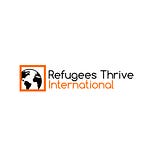Refugee children and the unique challenges they face
Written by Chris Opila, Refugees Thrive International Board Member
This story is the second in a three-part series about refugee children. Read part one here. Part three will be published on June 20, 2019, World Refugee Day.
Nelson Mandela once said, “There can be no keener revelation of a society’s soul than the way in which it treats its children.”
There are more than 25.4 million refugees worldwide. The MAJORITY of them are children. Of these 13.2 million refugee children, an increasing number are unaccompanied children, i.e. youths who have fled their homes and countries alone…without a parent or guardian. Mariam was one of them, and refugee children like her face particular challenges and vulnerabilities such as child labor, early marriage, and no access to education.
Child labor is illegal, but countless refugee children are working to ensure their and their family’s survival. Although neither United Nations Commissioner for Refugees (UNHCR), United Nations Children’s Fund (UNICEF), nor any other refugee service provider tracks refugee child labor in the aggregate, their reports emphasize that many refugee children — from as many as a quarter of refugee households in some cases — find employment in agriculture, street peddling, restaurants, garbage collection, construction, and various other industries. These refugee youths often perform strenuous labor that is harmful to their emotional, developmental, and physical well-being. Some have even become the primary breadwinner for their household.
The causes of refugee child labor are diverse, including legal barriers to adult refugee employment, inaccessibility of quality education, economic hardship, and the perception that children are less likely to be arrested or punished than adults for working unlawfully. But, the results of this labor are predictable. Instead of enjoying a childhood, many refugee children fall victim to forced or bonded labor, are conscripted into armed conflict, and trafficked for their exploitation — sexual and otherwise.
Child brides are supposed to be an anachronism, but many refugee girls are increasingly becoming them. In some host countries like Lebanon, a quarter of refugee girls between the ages of fifteen and seventeen are married. In others such as Jordan, it is as many as thirty-six percent. For refugee girls married as children, the results are often the same: they drop out of school, face a higher risk of early pregnancy and reproductive health concerns, and are more vulnerable to domestic violence than those who marry as adults. Yet, faced with high instances of kidnapping, sexual assault, and rape in refugee camps and informal settlements, some refugee households elect to marry their daughters as children in order to “protect” them. Other households, struggling to provide for their younger children, marry their daughters as children so that the responsibility of feeding, clothing, and sheltering them is passed to their husbands.
Education is a fundamental human right, but more than half of school-age refugee children are not receiving one. Even for those who are in school, only a quarter will attend secondary school and one in one hundred will access higher education. The reasons are many, including legal and/or fiscal barriers to enrollment in host country public schools, funding shortages for schools in refugee camps, teacher shortages, and economic pressure to work to support their families. Since the exile of many refugee children lasts for years, if not their entire childhood, they are increasingly becoming a lost generation, whose future is one of decreased job prospects and wages, increased child labor, marriage, and pregnancy, and untapped potential. But, the lucky minority who attend school not only obtain an opportunity to build a more optimal future, but also enjoy access to a space that allows them to be children, an environment in which they can play, make friends, and find mentors, and a setting that returns a sense of normality and control to their disrupted lives.
The Naimo Center, run by St. Andrew’s Refugee Services (StARS) and supported by Refugees Thrive International (RTI), provides a space for up to 3,500 children to be children as they adjust to life as refugees in a foreign country. Here unaccompanied minors are protected from sexual abuse, avoid child labor, access education and medical care and are connected to housing. The Center also serves as a space where youth come up with solutions specific to their needs and make their own life decisions.
You can take action and ensure that some of the most vulnerable children receive the support and protection they deserve by donating to the Naimo Center via RTI. Earlier this year, RTI proudly invested $100,000 to help StARS open the doors of the Naimo Center, which offers refugee youth wide-ranging assistance, including individualized psychosocial services, legal services, medical treatment, education, direct assistance, shelter, and emergency response in times of crisis. Help us make similar impact next year.
